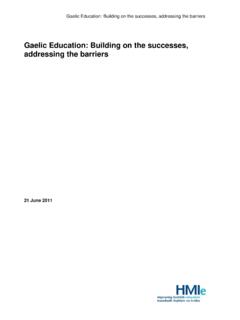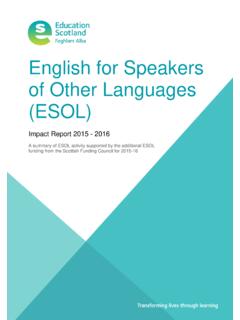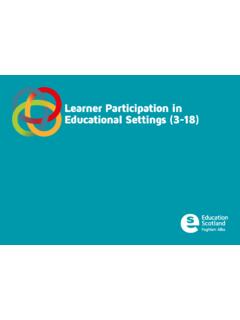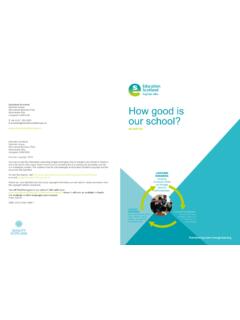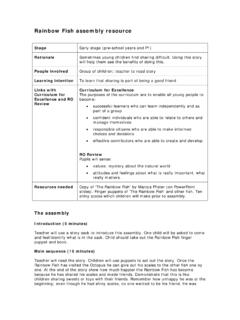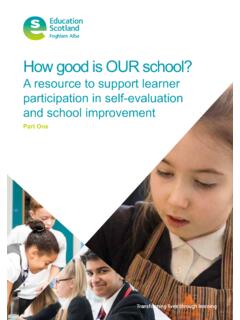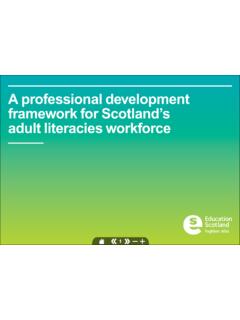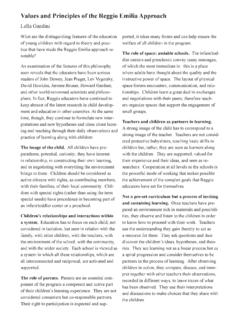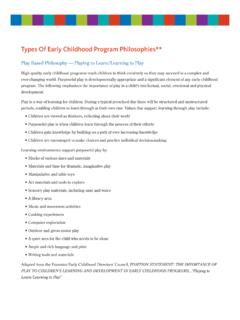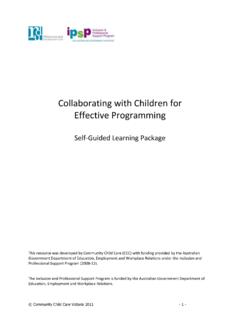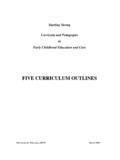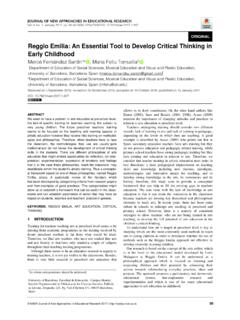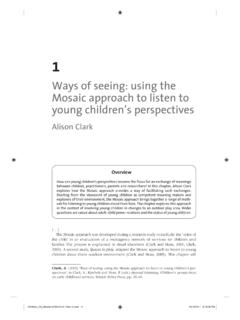Transcription of The Reggio Emilia Approach to - Education Scotland
1 The Reggio Emilia Approach to Early Years EducationAcknowledgementsI wish to express my sincere thanks to Pat Wharton, Diane Alexander and Eileen Carmichael for their generous contributions to the first and second editions of this would also like to thank all the children, educators and parents of the many Reggio schools who gave so generously of their time and answered my questions with enthusiasm and finally, a special thankyou to Ruben, Sebastian and Emily .. my three Reggio children!First published 1999 New edition published 2006 Learning and Teaching Scotland 2006 ISBN-13: 978-184399-136-6 ISBN-10: 1-84399-135-7 Reggio EMILIAiiiBackgroundGeneral InformationWhat is the Reggio Approach ? The Image of the Child The Expressive Arts in the Pre-school: The Hundred Languages Progettazione Community and Parent School Relationships Environment Teachers as Learners What can the Scottish Early Years Education System Learn from the Reggio Approach ?
2 Adaptation of a Pedagogical Approach Reflecting on Current Practice Physical Features Time Collaboration Partnership with Parents Curriculum The Role of the Adult Documentation Initial Teacher Training and Professional Development Bibliography Books News Articles Reports Conference Papers CONTENTSREGGIO EMILIAREGGIO Emilia BACKGROUNDIn educational terms the northern Italian town of Reggio Emilia has a firmly established worldwide reputation for forward thinking and excellence in its Approach to early childhood Education . North American and Scandinavian educators have long recognised the importance of the continuing educational development that is taking place in the Reggio model, and there is much about the Approach that is of interest to educators in Scotland . It is a socio-constructivist model. That is, it is influenced by the theory of Lev Vygotsky, which states that children (and adults) co-construct their theories and knowledge through the relationships that they build with other people and the surrounding environment.
3 It also draws on the work of others such as Jean Piaget, Howard Gardner and Jerome Bruner. It promotes an image of the child as a strong, capable protagonist in his or her own learning, and, importantly, as a subject of rights. It is distinguished by a deeply embedded commitment to the role of research in learning and teaching. It is an Approach where the expressive arts play a central role in learning and where a unique reciprocal learning relationship exists between teacher and child. Much attention is given to detailed observation and documentation of learning and the learning process takes priority over the final product. It is a model that demonstrates a strong relationship between school and community and provides a remarkable programme for professional this paper was first written, in 1998, the town of Reggio Emilia has undergone significant change and evolution at a socio-cultural and demographic level.
4 The population of this medium sized Italian town was 135,406 in 1995 and according to the 2004 census now stands at This population growth is due to a number of factors, such as the increase of the average lifespan, an increase in the birth rate (which is significantly higher than in other parts of northern Italy) and increasing immigration both from other parts of Italy and from other countries, both within and outwith the European Emilia is a very prosperous town that boasts a strong cultural heritage, historic architecture and beautiful squares. The citizens of Reggio Emilia are served by generally efficient public services. The town has a strong tradition of co-operation and inclusion that cuts across social and economic boundaries, and politically the people continue to show their support for the Socialist Parties.
5 Increased immigration, however, has undoubtedly created new challenges for Reggio Emilia and the town is experiencing a period of transition in terms of cultural awareness. The number of non-European immigrants resident in Reggio Emilia has risen from 5090 in 1997 to 15,052 in 2005. This is an increase which has not gone unnoticed by Italians. Equally, while local government remains committed to the development of social policies that actively support families and children, there is an increasing sense of precariousness in early childhood services because of national government legislation. As ever, educators, parents and citizens in Reggio Emilia have been vocal in protesting against such economic cuts and reduction in staff numbers. Indeed, at the time of writing there have been protests in the form of signing petitions and opening pre-school establishments to the public on Saturday mornings with the purpose of highlighting this precariousness.
6 1 Census figures and population growth figures are cited from Reggio in Cifre published by Comune di Reggio Emilia , Emilia The Education that the Reggio schools provide is the result of a long and gradual process that continues to evolve. We must look back to the period immediately after the Second World War to understand the genesis of what has become known as the Reggio Approach . Two factors can be seen to have had a fundamental and far-reaching was the parents and citizens of Reggio Emilia who, in a show of collective responsibility and the desire to create a better society for their children, occupied a disused building that they turned into the first nursery school. This and the other schools that followed were quite literally built by the effort and will of the parents was given direction through the extraordinary vision of Loris Malaguzzi, at the time a young teacher, who dedicated his life to the development of the philosophy now known as the Reggio Approach .
7 In 1963 the local council or municipality opened the first municipal pre-school establishments for children of 3 6 years and in 1970 these were joined by the first infant-toddler centres for infants from three months to 3 years. In the late 1960s the original schools founded in the post-war period were integrated into the municipal system and given renewed the start the municipal-run schools have been committed to progressive thinking and the advancement of an educational project that centres on the child. For these reasons the Reggio schools have attracted significant global interest and received international accolades. Foreign interest originally began in the 1970s with the creation of a touring exhibition of the work taking place in the schools. The exhibition was originally called The Eye Jumps over the Wall and is now known as The Hundred Languages of Children.
8 It has been shown throughout the world and continues to evolve. The number of people worldwide who visit the schools and attend the conferences organised by the private organisation called Reggio Children continues to increase. Reggio Children was founded in 1995 in response to the level of global interest in Reggio and has as its full title The Centre for the Promotion and Defence of the Rights of Children. It aims to share its expertise both nationally and internationally and promote research in the field. As a result of exemplary work being done, a number of awards have been bestowed on the schools and the people involved: in 1992, the late Loris Malaguzzi, the founder of the philosophy, was awarded the Danish LEGO Prize for his outstanding work in the field of early childhood Education in 1993, Reggio schools were given an award by the Kohl Foundation in Chicago in 1994, the Hans Christian Andersen Prize was awarded to the schools in recognition of their 1995 two important events took place.
9 Dr Jerome S Bruner visited the schools and was so deeply impressed by the experience that he established a relationship with the schools based on promoting and improving educational systems globally. A link between Reggio and the Italian Ministry of Education was also established with the aim of creating a common programme of professional development throughout the EMILIAREGGIO Emilia Many prizes have been bestowed on the Reggio Emilia 0 6 school experience between 1995 and 2006. Examples of these are: in 2000, the Klods Hans Prize 2000 was awarded by the city of Hirsthals, Denmark, for commitment to the defence and development of children s rights in the field of Education in 2001, a prize was awarded by the city of Blois, France, in recognition of the quality of the educational experience in 2001, the Gold Medal for merit in schools, culture and art was awarded by Carlo Azeglio Ciampi, President of the Republic of Italy, in memory of Loris Malaguzzi in 2002, the Nonino Prize for an Italian maestro of our times was awarded to the educational project for early childhood in the municipality of Reggio the time of writing, perhaps the most significant event in the development of this unique educational experience has been the opening (February 2006)
10 Of the Loris Malaguzzi International Centre of Childhood. The centre, which is partially open to the public, is still in the development phase but it has already been host to different exhibitions and meetings on the theme of childhood and Education . It now has conference rooms, a theatre, exhibition spaces and working creative and scientific ateliers which were developed by parents in conjunction with educators and atelieristas. The next phase will see the opening of restaurants and a new pre-school establishment on the site. Crucially, the international centre is seen as a place for the defence and promotion of the rights of all children and young people. The atelier and other spaces will be used by children and young people up to 18 years of age, a step which highlights the town of Reggio Emilia s commitment to all young people and not just children of pre-school age.
